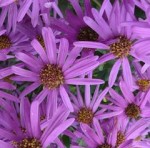 Italian aster is a herbaceous perennial belonging to the aster family, Asteraceae, that also includes daisy, yarrow, and lettuce. The plants grow in bushy clumps and have well branched hairy stems. The oblong to lanceolate leaves are also hariy and are up to six inches long. They are entire and sessile. The fragrant flowerheads have violet-purple ray flowers surrounding yellow disc flowers and are 1.5 to 2 inches across. They and are borne in terminal clusters from late summer into fall over a long bloom time. Several cultivars are available that are one to two feet tall, do not usually need staking, and have colors that are superior to the species. Although plants survive in the heat and humidity of zones 7 and 8, they grow better in the cooler part of their range. The generic name Aster comes from the Latin word aster meaning star and refers to the shape of the flower. The specific epithet amellus is the Latin name for the plant.
Italian aster is a herbaceous perennial belonging to the aster family, Asteraceae, that also includes daisy, yarrow, and lettuce. The plants grow in bushy clumps and have well branched hairy stems. The oblong to lanceolate leaves are also hariy and are up to six inches long. They are entire and sessile. The fragrant flowerheads have violet-purple ray flowers surrounding yellow disc flowers and are 1.5 to 2 inches across. They and are borne in terminal clusters from late summer into fall over a long bloom time. Several cultivars are available that are one to two feet tall, do not usually need staking, and have colors that are superior to the species. Although plants survive in the heat and humidity of zones 7 and 8, they grow better in the cooler part of their range. The generic name Aster comes from the Latin word aster meaning star and refers to the shape of the flower. The specific epithet amellus is the Latin name for the plant.
Type: Herbaceous perennial
Bloom: Violet-purple ray flowers surround yellow disc flowers carried in clusters from late summer into fall.
Size: 2-2 ½’ H x 2’ W
Light: Full sun
Soil: Fertile, moderately dry, well-drained (but overly fertile soil may result in excessive growth and the need for staking); some drought tolerance
Hardiness: Zones 5-8
Care: Pinch back 2-3” in spring and early summer (before June 15 in the North, before July 1 in the South) to produce compact dense plants.
Pests and Diseases: Verticillium wilt ; galls; bacterial spots, blights and rots; Downy mildew; cankers, dieback, and wilt; slugs, snails, aphids; leaf and bud eelworms
Propagation: Division in spring or fall every two to three years; root basal cutting in spring
Companion plants: Japanese anemone, Sedum spectabile, garden mums in burnt orange, ornamental grasses
Outstanding Selections:
‘King George’ (deep purple flowers, 2-3’ tall; does not need staking; very floriferous)
‘Rudolph Goethe’ (violet flowers, 2-3’ tall)